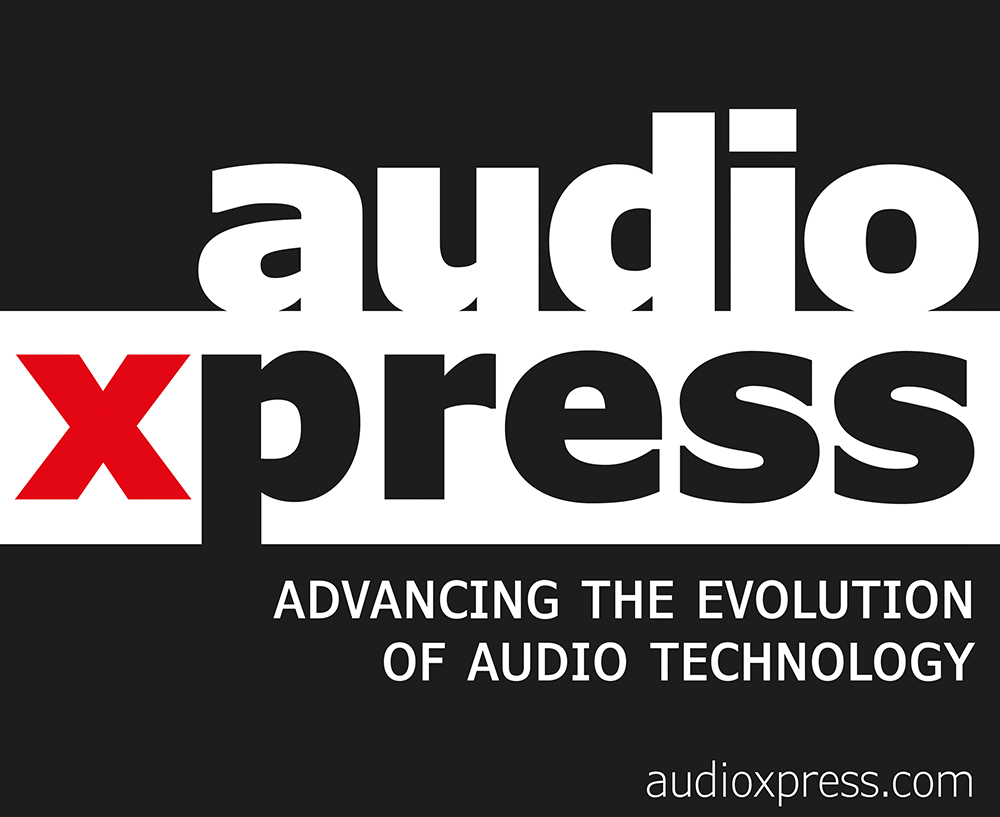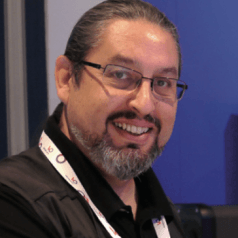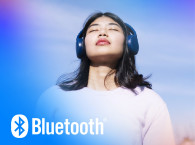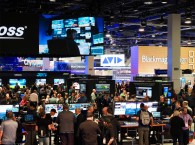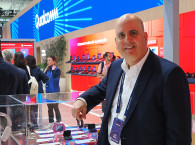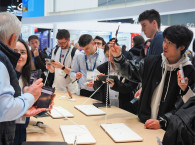At the Venetian, which is the heart of the B2B activities for any audio-related technologies, things were better than ever. The suites everywhere were purely for business and not open exhibits “hifi style” as happened in the past. As a result, there were no more long queues for the elevators to the upper floors of the Venetian, and the corridors and central hall were a great environment for networking. As always, by simply walking in those hallways and waiting for the elevator one meets more people than is humanly possible with an intense meetings agenda. So, in that regard, CES 2025 was better than ever. Quality over quantity, any time.

Yes, CES 2025 was more dispersed than ever, with the Las Vegas Convention Center (LVCC) spreading from the vibrant new West Hall, now completely centered around automotive and mobility technology, all the way to the South Hall, which had nearly 60% of its two floors full of exhibitors. The LVCC Central Hall was again a vibrant display of great brands, centered around the TV manufacturers and the gaming industry. But the biggest surprise was the already renovated North Hall, where one could find a great number of new companies at the cutting edge of artificial intelligence, intermixed with more mobility and materials science. Although the outside of the LVCC this year was an immense construction site, the internal flow among the renovated halls, without ever having to go outside, worked well for those who dared to walk the extra mile.
So, I’ll cut to the chase to say that CES 2025 was extremely successful, even with the impression of fewer people because of the show being even more dispersed. The Venetian Expo was extremely vibrant this year, with health, sensor, AR/XR, and semiconductor exhibits enabling a sense of the fast pace of technology evolution. Together with the hospitality and business suites everywhere in the Venetian and Palazzo towers (plus all the suites in neighboring hotels, from the Wynn to the Flamingo), it was clear that audio was ever more omnipresent this year and there was more to see.


Otherwise, the numbers are solid, with more than 4500 exhibitors (4300 in 2024), including 1400 startups, and more than 6000 media attendees. That continues to match or surpass what happened in 2023 and 2024, with an impressive record number of startups from around the globe continuing to flock into the Eureka Park. This year, the country pavilions were more numerous and even bigger than ever - and not only for startups. European countries and even a representation of the European Union brought more companies and entrepreneurs, escorted by more government officials than ever.
This also confirms that CES is increasingly about innovation, product development, and supply chain ecosystems, and less about distribution and retail, as it was clearly the focus in the past. That is also reflected in the attendance profile, which is much more technical and business-oriented with more engineers, product managers, and high-profile C-level executives.

The new CTA president, Kinsey Fabrizio, summarizes this transition in her words about the show: "From groundbreaking innovations that improve lives to transformative ideas that redefine industries, CES is a celebration of the art of the possible, showcasing how technology enriches our world and inspires a brighter future for all. The evolution of CES has surged at this year's show, where creativity, connectivity, and innovation inspire with visionary keynotes, thought-provoking conference sessions, and mind-blowing exhibits."


As I expected, independent of being audio-centric or not, the booths and demonstrations I visited had a common denominator in AI. Although our interest was always in audio technology, we’ve seen better and more mature examples of how AI, and in particular edge-AI (running purely on-device), is transforming what is possible.
Of course, CES 2025 was intense in all the hype around artificial intelligence. Anything that used to be about IoT, Smart, or Voice, is now about AI, even where there’s no glimpse of intelligence of any sort. And in that hype category, we could find ring sensors (which somehow are able to run complex models...) and all sorts of “something glasses,” replacing the attention that used to be centered around smart watches.
I liked the CTA statement that “CES 2025 connected the dots between humanity and AI through powerful exhibits and programming. From AI-driven productivity tools to breakthroughs in medical advancements, products and services on the show floor demonstrated that artificial intelligence is not just a technology trend but a transformative force improving lives worldwide.” It sounds accurate, until we visited the Samsung booth and saw the demos of people talking to appliances, a complete déjà vu from 2018, when personal voice assistants were all the hype (and were still artificially dumb).
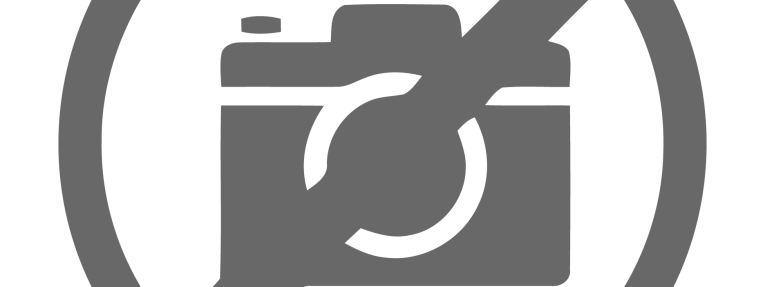

And that is precisely what is happening in the related area of hearing assistance and audiology. CES 2025 was rich in announcements of new AI-enabled devices, as an evolution of the “adaptive processing” that was introduced previously. In that regard, there is a common thread with what the mainstream consumer electronics and large tech companies are trying to do in earbuds and headphones. At CES 2025, I have focused my attention on that domain, and I could see that there are significant and remarkable advancements in all fronts.
Removing undesired noises in real time is a basic approach. Voice isolation in the middle of overlapping conversations is another common project. And binaural spatialization of direction of arrival is another focus. In combination, all can significantly contribute to “smart hearables” and effective listening assistance and augmentation. Audio AI is demonstrating the ability to accelerate more challenging form factors, such as glasses and open earbuds with active processing.


I also saw demonstrations that take the concept one step further, enabling complete source separation and even voice synthesis, or extremely complex processing in hardly recognizable speech, but those were mostly still running on a smartphone, a laptop, or a server. No question, these will be running on-device in around two years.
Another area of significant progress in the AI-related demonstrations I witnessed has to do with sensor fusion and multi-connectivity, which is for now key for the convergence between the smart home, mobility, and personal audio experiences. Radar applications, presence detection, and multi-axis motion detection are all areas that are seeing significant progress and benefiting from a convergence of a series of technologies, including ultrasound, Ultra-Wideband (UWB), and Bluetooth Channel Sounding. This makes me predict that very soon we will be able to do with gestures all those many things that we have been suggested to do with voice commands, and that are simply too awkward in a social context. Once we try gesture control, and our devices simply “detect us” and anticipate our preferences, voice control is completely redundant, except in a very reduced number of scenarios (driving being one of those, and any situation that requires truly hands-free interaction).
Honestly, I see these AI-enabled examples as much more significant and exciting than all the hype that was propelled at CES 2025, resulting from the Jensen Huang (NVIDIA founder and CEO) keynote where things like real-time assistants and advanced robotics navigation were touted. Funny enough, the Japanese companies seem to be the most excited with the convergence between the virtual fantasy worlds and AI. From the Sony and Honda car that reflects the universe of action heroes, to fully immersive virtual entertainment solutions, Japan seems to be ahead in the most radical and bizarre concepts. And it continues to be the number one market for expensive wired IEMs using multiple drivers, which is also strange.


I cannot at this time get into details about specific companies and products that we saw - other than some of the examples illustrated in the selected photos. Those will be covered on the audioXpress website with dedicated articles, all found under the metatag CES 2025.
Other than the edge AI developments to which I previously alluded, I will briefly mention some examples of technology trends that in my opinion were the highlights - and are all relevant to the audio industry.
And I will start with Qi2, USB-C, and Power Delivery. These are all directly related to enabling interfaces that define the consumer electronics industry of today. It’s obvious that USB-C is now the dominant standard connector, and that the related USB Power Delivery specification is crucial to understanding today’s designs.
Independently of the evolving specifications - not sure how many product designers have stopped what they were working on when the USB Implementers Forum (USB-IF) announced the latest USB4 Version 2.0 specification... I know - because I ask - that hardly anyone even knows about USB4, and this update was announced in March 2019. This major update now enables up to 120Gbps of data performance over the USB Type-C cable and connector, and benefits data-intensive applications, such as high-performance displays, storage, and USB-based hubs and docks. This specification also introduced USB data architecture updates to enable Enhanced SuperSpeed USB data tunneling to exceed 20Gbps and aligns with DisplayPort Revision 2.1 and PCI Express Revision 4. As always, it ensures backward compatibility with all previous versions of USB.
USB-C/USB Power Delivery (USB PD) specifications were also updated to enable this higher level of performance. As a reminder, USB PD 3.2 enables up to 240W of power over USB Type-C cables and connectors, extending USB PD beyond 100W. The new Adjustable Voltage Supply (AVS) feature enables the device under charge to manage the charger by requesting specific voltages to 100mV resolutions. It is mandatory at 15V and above for chargers in excess of 100W, and mandatory at 9V and above for charges less than 100W. The specification defines three additional fixed voltages: 28V, 36V, and 48V. The USB Type-C specification was also updated to Release 2.1, which defines 240W cable requirements.

According to the Wireless Power Consortium (WPC), which defines these standards, Qi2 wireless charging expanded exponentially and is about to accelerate in 2025 as a new generation of Qi2 Android devices comes to market, with Samsung and Google leading the charge. “The centerpiece of wireless charging, Qi2 (pronounced ‘chee two’), was introduced only last year, and already more than 1.5 billion devices worldwide benefit from its advantages of greater convenience, faster charging, and higher efficiency,” the organization stated. The WPC also reveals that in the one year since its launch, more than 1100 new Qi2 products have been certified, which is a remarkable 6-fold faster adoption rate when compared with the previous version of Qi.
Why is this important? For anything that is battery-operated, as soon as consumers realize how consistent and fast the charging is using a Qi2 charger, they tend to embrace it much more. And as they get familiar with the snap-on experience that these solutions offer, the Qi2 ecosystem becomes a new standard also for simply attaching accessories of all types, from extra batteries to portable speakers. Unlike the original Q1 wireless surfaces that frequently failed the alignment that allowed the device to charge, Qi2 features a magnetic attachment and provides fast charging.
The WPC is now focused on a new extension for the automotive industry, rolling out in 2025, that features a wireless phone charger with a moving coil. The goal is to enable the benefits of Qi2’s magnetic attachment even for older smartphones, with the moving coil looking for the phone’s exact location so it can provide fast and efficient charging speeds. Panasonic Automotive Systems (PAS) contributed the technology for the new moving coil feature.

I cannot give specifics at this stage, but the idea is simple. Audio multichannel for home cinema could be the strong use case to motivate evolving Bluetooth to support High Data Throughput (HDT). As seen in the recent announcement from Ceva with its Ceva-Waves Links200 solution, the first complete multiprotocol wireless connectivity platform that supports Bluetooth HDT is now available. And as Ceva declared, by embracing this next-generation technology that enables data rates up to 8Mbps, Bluetooth devices could finally support higher-quality streaming media, but it could also enable advanced applications such as 7.1 wireless audio systems and beyond.
With the audio industry frustrated with the existing solutions over Wi-Fi, Bluetooth HDT could finally enable a universal solution for wireless multichannel. There is still a possibility that this could also happen over UWB before there is a Bluetooth alternative, but given the number of companies supporting Bluetooth versus those working to enable audio streaming over UWB, I’m afraid that the window for any alternative approach could quickly close.
And talking about home cinema and multichannel applications, CES 2025 was rich in announcements related to Spatial Audio and 3D sound. Again, I saw really exciting demonstrations in this area. But that will need to be the topic of a separate article. aX
This article was originally published in The Audio Voice newsletter, (#499), January 16, 2025.
